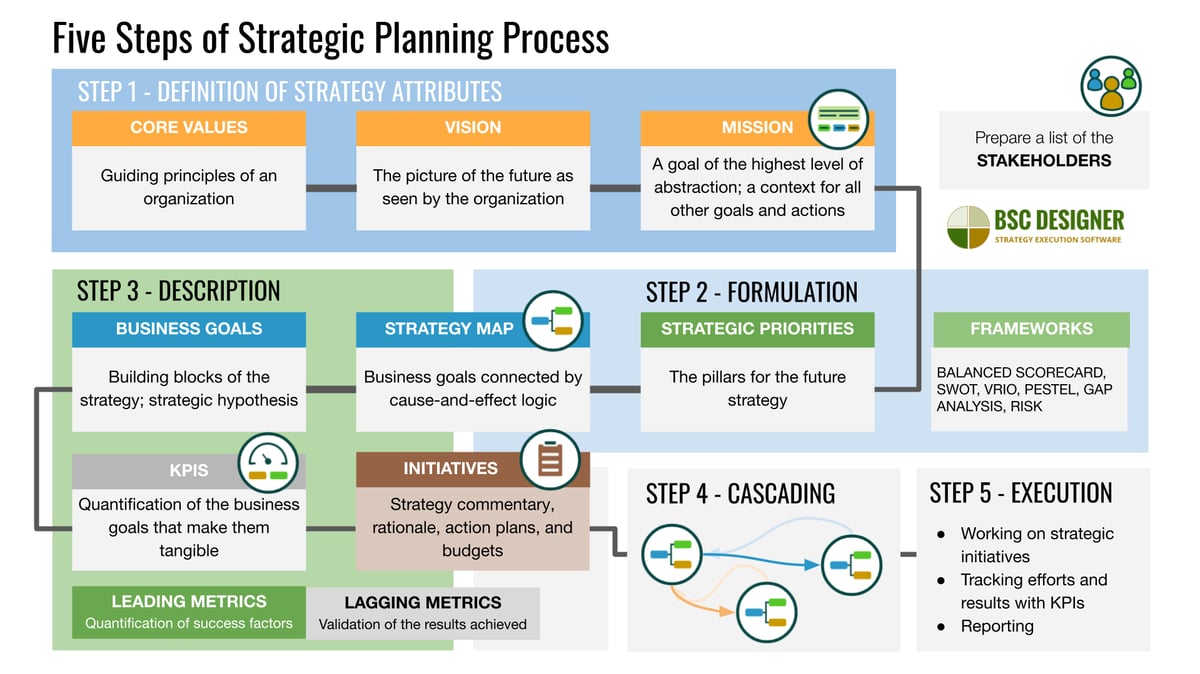You’ve seen it before: an executive team spends months crafting a strategic plan. The PowerPoint looks polished. The goals sound ambitious. But six months later—nothing’s changed.
Why?
Because strategy without execution is just a dream.
According to Wharton professor Lawrence G. Hrebiniak, 67% of well-formulated strategies fail due to poor execution (Making Strategy Work, 2005). Further research published in Harvard Business Review found that among 400 global CEOs, the #1 challenge in business wasn’t strategy development—it was executional excellence (Sull et al., 2015).
What most teams lack is a bridge between strategy and operations.
That’s exactly what the Five Steps of Strategic Planning offers—a clear roadmap from defining your purpose to executing measurable results. Developed by BSC Designer, this framework has been used by companies of all sizes to close the gap between thinking and doing.
Let’s break it down.

The first step isn’t about setting goals or KPIs. It’s about answering the big questions:
This foundational phase sets the tone for everything that follows.
Your values are the non-negotiable principles that shape your organization’s culture and decision-making.
Examples:
These values should guide hiring, product design, and how your team behaves under pressure.
Your vision is a long-term, aspirational outcome. It defines the future you’re building.
Example: “To accelerate the world’s transition to sustainable energy.” – Tesla
Vision is your compass. It tells your team, investors, and customers where you’re headed.
The mission answers, “What do we do, for whom, and why?”
Example: “To organize the world’s information and make it universally accessible and useful.” – Google
A strong mission grounds your team in purpose and clarity.
✅ Pro Tip: At this stage, align key stakeholders early. Strategic misalignment here will ripple through every other step.
Now that you know your “why,” it’s time to translate that into clear, directional priorities.
This is where you define what matters most—the big bets your organization will make.
These are the 3–5 critical focus areas that will drive progress toward your vision.
Examples:
These are not tasks—they’re themes that guide all decisions, resource allocation, and measurement.
Support your formulation process using structured thinking tools:
Don’t overcomplicate it. Use 1–2 tools to get clear, then move forward.
This is where strategy becomes real and operational.
Break down each strategic priority into SMART goals (Specific, Measurable, Achievable, Relevant, Time-bound).
Example: “Increase Net Revenue Retention (NRR) from 100% to 120% in 12 months.”
Visualize how goals are connected through cause and effect.
Improved onboarding → Higher activation rate → Increased retention → Lower CAC
These maps create clarity across teams and ensure everyone understands the bigger picture.
Measure progress using a mix of:
Use dashboards to track these continuously.
These are the projects and action plans that make your goals happen.
Initiative Example: Redesign onboarding flow by Q2 with a €15k budget and a target of +20% activation.
Each initiative needs:
📌 Reminder: Every initiative must tie directly to a goal and strategic priority. If it doesn’t, cut it.
This is where many strategies break down—when they don’t reach the people doing the work.
Cascading means translating strategy into departmental and individual objectives.
🎯 Example:
Use OKRs (Objectives and Key Results) or Balanced Scorecards to structure this.
✅ Pro Tip: Run workshops to co-create goals with each team. People commit to what they help build.
Strategy is only as good as its execution. This final step turns plans into results.
Ensure every initiative has:
Use agile sprints or project plans to manage progress.
Don’t wait until the quarter ends to check performance. Set a rhythm:
Use automated dashboards to stay data-driven.
Execution is dynamic. Review what’s working, what’s not, and adjust fast.
Strategy is not a set-and-forget exercise—it’s a living process.
To make this framework sustainable, embed it into your operating cadence:
FrequencyActivityAnnualVision refresh, strategic priorities updateQuarterlyKPI planning, goal setting, resource allocationMonthlyProgress reviews, initiative check-insWeeklyTactical syncs, blocker resolution
This rhythm keeps teams aligned and strategy alive.
Depending on your organization’s size and maturity, you’ll need tools for planning, tracking, and collaboration.
Many growing companies and large organizations rely on SAP’s integrated suite:
In the early stages, you may use simpler tools such as:
🧭 Tip: Start simple. Use what your team already knows. As you grow, consider enterprise solutions that scale with you.
Disclaimer: The views expressed in this article are my own and do not represent SAP. Mentioned tools are illustrative only.
Strategy execution is your competitive advantage.
It’s what separates companies that talk about growth from those that actually scale. The Five Steps of Strategic Planning offers a structured, repeatable way to:
Whether you're running a startup, scaling a business, or innovating within a large company—this framework will help you close the gap between vision and impact.
If you're building your next strategy—or struggling to execute your current one—I’d love to help.
As a top-rated mentor on MentorCruise, I support founders, operators, and corporate leaders in designing high-impact strategic systems.
✅ Book a session if you want to:
Let’s move from vision to execution—together. 🚀
#StrategyExecution #StartupLeadership #OKRs #MentorCruise #KPI #ExecutionDiscipline #BusinessGrowth #StrategicPlanning #CorporateInnovation
Find out if MentorCruise is a good fit for you – fast, free, and no pressure.
Tell us about your goals
See how mentorship compares to other options
Preview your first month
